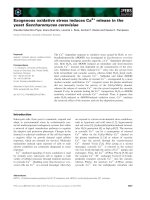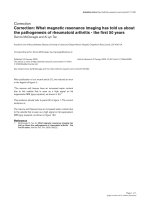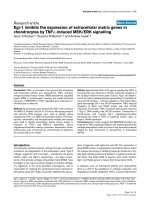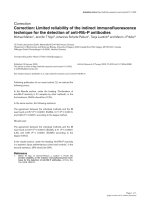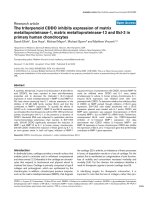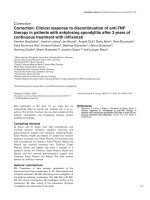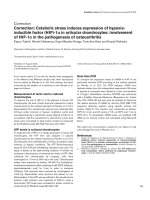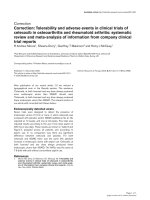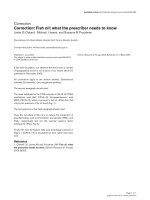Báo cáo y học: "Correction: Catabolic stress induces expression of hypoxiaα inducible factor (HIF)-1α in articular chondrocytes: involvement α of HIF-1α in the pathogenesis of osteoarthritis" pps
Bạn đang xem bản rút gọn của tài liệu. Xem và tải ngay bản đầy đủ của tài liệu tại đây (30.41 KB, 1 trang )
225
Available online />In our recent article [1], we did not identify three paragraphs
in the Material and Methods section that were reproduced
from an article by Pfander et al. [2]. This omission has been
corrected by the addition of a reference to the Pfander et al.
paper as follows:
Measurement of lactic acid in cultured
chondrocytes
To examine the role of HIF-1α in the glycosis in human OA
chondrocytes, the level of lactic acid was measured in culture
chondrocytes by the method reported by Pfander et al. [21].
Supernatants from chondrocyte cultures were collected after
24 hours under normoxic or hypoxic conditions. Lactic acid
was determined by a colorimetric assay (Sigma) at 540 nm in
accordance with the manufacturer’s instructions. Lactic acid
levels were normalized to total protein content as measured
by the Bradford assay (Bio-Rad, Hercules, CA, USA)
ATP levels in cultured chondrocytes
To study the role of HIF-1α in energy generation in human OA
chondrocytes, the ATP level was analyzed in cultured
chondrocytes by the method reported by Pfander et al. [21].
Chondrocytes were collected after a 24-hour incubation under
normoxic or hypoxic conditions. The ATP Bioluminescence
assay kit CLS II (Roche, Heidelberg, Germany) was used. The
assay is based on the light-emitting oxidation of luciferin by
luciferase in the presence of extremely low levels of ATP. After
collecting the chondrocytes by scraping, cells were
centrifuged for 10 min at 500 × g in the cold. Chondrocytes
pellets were extracted by boiling 100 mM Tris (tris(hydroxy-
methyl)aminomethane) buffer containing 4 mM EDTA (ethylene-
diaminetetraacetic acid) for 2 min in order to inactivate
NTPases. Cell remnants were removed by centrifugation at
1000 × g. Supernatants were removed and placed on ice.
Determination of free ATP was as outlined in the manufacturer’s
protocol. Light emission was measured at 562 nm using a
luminometer. ATP levels were normalized to protein content as
measured by the Bradford assay (Bio-Rad) [19].
Real-time PCR
To compare the expression levels of mRNA for HIF-1α we
performed real-time PCR according to the method reported
by Pfander et al. [21]. For PCR analyses, cDNA from
triplicate dishes from four independent experiments (24 hours
of hypoxia or normoxia) were diluted to a final concentration
of 10 ng/µl. Quantitative real-time RT-PCR was performed
with a TaqMan Universal Mastermix (Biosystems Inc, Foster
City, CA). cDNA (50 ng) was used as template to determine
the relative amounts of mRNA by real-time PCR (ABI 7700
sequence detection system) using specific primers and
probes (Table 2). The reaction was conducted as follows:
95°C for 4 min, and 40 cycles of 15 s at 95°C and 1 min at
60°C [21]. To standardize mRNA levels, we amplified 18S
rRNA as an internal control and calculated using Microsoft
Excel.
We regret any inconvenience caused by our failure to fully
acknowledge the work of Pfander et al.
References
1. Yudoh K, Nakamura H, Masuko-Hongo K, Kato T, Nishioka K:
Catabolic stress induces expression of hypoxia-inducible
factor (HIF)-1
αα
in articular chondrocytes: involvement of HIF-
1
αα
in the pathogenesis of osteoarthritis. Arthritis Research &
Therapy 2005, 7:R904-R914.
2. Pfander D, Cramer T, Schipani E, Johnson RS: HIF-1alpha con-
trols extracellular matrix synthesis by epiphyseal chondro-
cytes. J Cell Sci 2003, 116:1819-1826.
Correction
Correction: Catabolic stress induces expression of hypoxia-
inducible factor (HIF)-1
αα
in articular chondrocytes: involvement
of HIF-1
αα
in the pathogenesis of osteoarthritis
Kazuo Yudoh, Hiroshi Nakamura, Kayo Masuko-Hongo, Tomohiro Kato and Kusuki Nishioka
Department of Bioregulation, Institute of Medical Science, St. Marianna University School of Medicine, Kawasaki, Japan
Corresponding author: Kazuo Yudoh,
Published: 31 August 2005 Arthritis Research & Therapy 2005, 7:225 (DOI 10.1186/ar1822)
This article is online at />© 2005 BioMed Central Ltd
